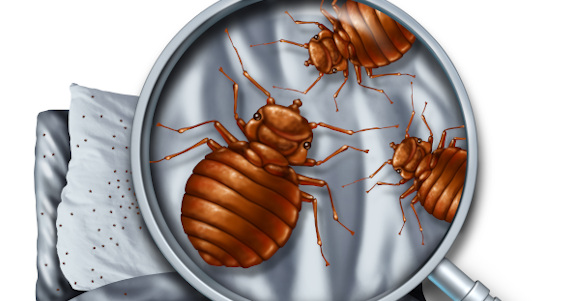Introducing the Science Behind Bed Bug Treatment Solutions
Introducing the Science Behind Bed Bug Treatment Solutions
Blog Article
Discover the most effective Bed Insect Treatment Techniques for Your Insect Control Plan
When encountered with a bed bug problem, determining the most efficient treatment techniques ends up being essential for successful insect control. Selecting the finest bed pest treatment method customized to your specific scenario is crucial for attaining lasting outcomes.
Identifying Bed Pest Problems
Recognizing indicators of a bed insect infestation can be essential in effectively dealing with the issue and avoiding additional spread in a timely fashion (Bed bug treatment). Bed pests are elusive insects that hide throughout the day and appear during the night to eat blood. Usual indications of a bed bug infestation consist of reddish-brown spots on bed linens or furniture from crushed bugs, tiny dark places that are bed bug excrement, lost skins in locations where bed bugs conceal, and a wonderful, mildewy odor in severe problems
Trigger recognition of a bed bug invasion is important to protect against the situation from escalating and needing a lot more extensive treatment techniques. If you believe a bed bug infestation, it is recommended to look for expert insect control support to effectively remove the insects from your home.
Non-Chemical Treatment Methods
Non-chemical therapy methods use reliable options for resolving bed bug infestations without depending on traditional chemicals. Warmth treatment is one such technique that entails raising the temperature level in infested locations to degrees that are dangerous to bed insects. Additionally, heavy steam therapy can be used to kill bed bugs and their eggs by subjecting them to high temperatures, making it a useful non-chemical alternative for combating infestations.
Chemical Therapy Choices
Having actually explored efficient non-chemical approaches for dealing with bed bug invasions, it is important to take into consideration the efficacy of chemical treatment choices in combating these resilient parasites. Chemical treatments play an important duty in bed pest control, particularly in serious problems where non-chemical approaches may not supply sufficient relief. There are various types of chemical treatments offered for dealing with bed bugs, including insecticides, desiccants, and insect growth regulators.
Pesticides are typically used to eliminate bed insects on call and offer recurring security against future invasions (Bed bug treatment). Desiccants function by damaging the external waxy layer of bed pests, leading to dehydration and fatality. Insect development regulatory authorities disrupt the bed insect life cycle by preventing their advancement from nymphs to adults, ultimately decreasing the population in time
When thinking about chemical therapy options, it is vital to focus on safety and security by following label instructions, using suitable safety equipment, and considering the possible dangers to pets and human beings. Consulting with a specialist parasite control service can help identify the most risk-free and reliable chemical treatment for your specific bed pest problem.
Integrated Bug Monitoring Strategies

IPM strategies for bed bug control may include detailed examination to identify the degree of infestation, recognition of crucial harborage sites, and implementation of cleanliness measures. In addition, decreasing clutter, securing splits and crevices, and eliminating prospective concealing spots can aid discourage bed pests from developing themselves.
In addition, non-chemical control approaches such as warm treatment, vacuuming, heavy steam cleaning, and making use of bed insect traps can be reliable elements of an IPM strategy. These techniques target bed insects at numerous life stages and interrupt their reproductive cycle, causing population decrease.
Routine surveillance and follow-up evaluations are critical in IPM to evaluate the effectiveness of control procedures and make necessary adjustments. By integrating incorporated parasite administration methods right into your pest control plan, you can accomplish long-term success in taking care of bed insect infestations.
Professional Extermination Solutions
Specialist elimination solutions offer customized competence and sources for efficiently getting rid of bed pest problems. Bed bug infestations can be especially testing to deal with because click to read of their strength and ability to hide in various cracks and crevices. Professional pest control operators are educated to determine the indications of bed insects, situate their hiding places, and use targeted therapy approaches to remove them effectively.
When selecting a specialist elimination solution for bed pest control, it is vital to seek certified and licensed pest control firms with experience in dealing especially with bed pests. These specialists have accessibility to a series of therapy choices, including chemical and non-chemical methods, to successfully battle bed insect infestations while guaranteeing the security of residents and animals.
Furthermore, professional exterminators can supply follow-up assessments and therapies as needed to make sure that the invasion is fully eliminated. Their experience in bed insect behavior and treatment methods can help protect against future problems, providing tranquility of mind for home owners and services alike. When encountered with a stubborn bed pest infestation, employing the services of professional pest control operators is usually one of the most trusted service to attain total removal.
Final Thought

When encountered with a bed insect infestation, recognizing the most effective treatment approaches becomes critical for successful parasite control. Typical indications of a bed pest infestation include reddish-brown spots on bedding or furnishings from smashed bugs, tiny dark areas that are bed insect excrement, dropped skins in areas where bed pests conceal, and a wonderful, stuffy smell in severe invasions.
Having actually the original source explored efficient non-chemical techniques for attending to bed pest infestations, it is vital to take into consideration the efficiency of chemical therapy options in combating these durable insects. Chemical treatments play a crucial role in bed bug control, specifically in extreme problems where non-chemical techniques may not provide sufficient alleviation. By incorporating these various treatment approaches into a detailed parasite control strategy, individuals can efficiently manage and remove bed insect infestations in their homes or organizations.
Report this page